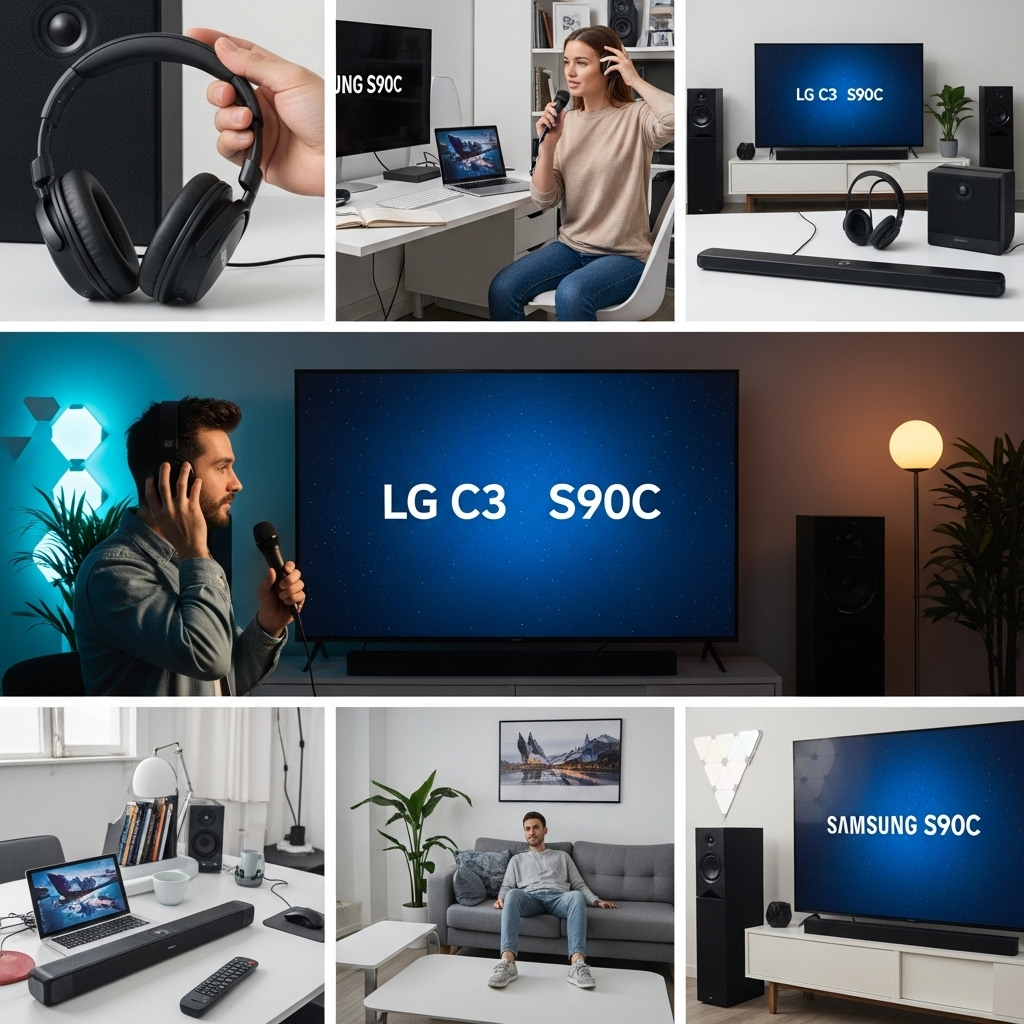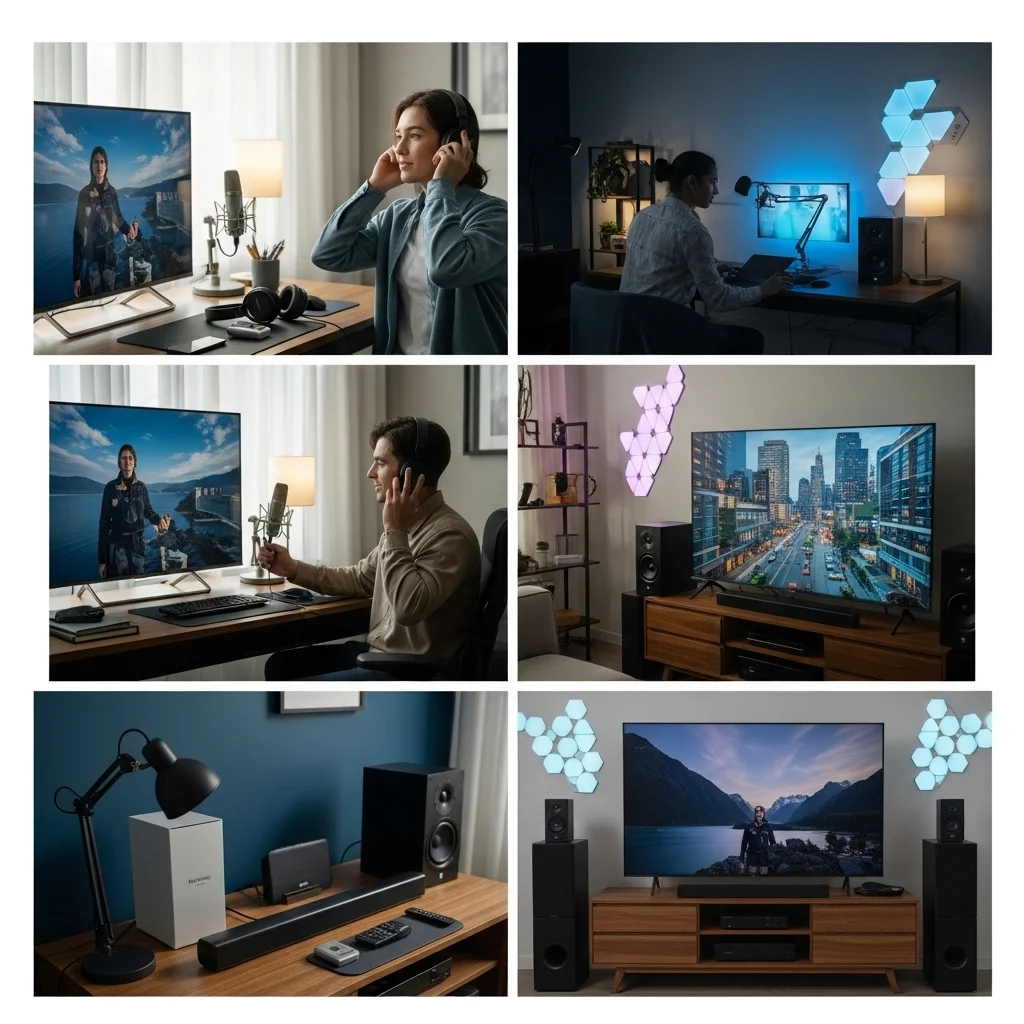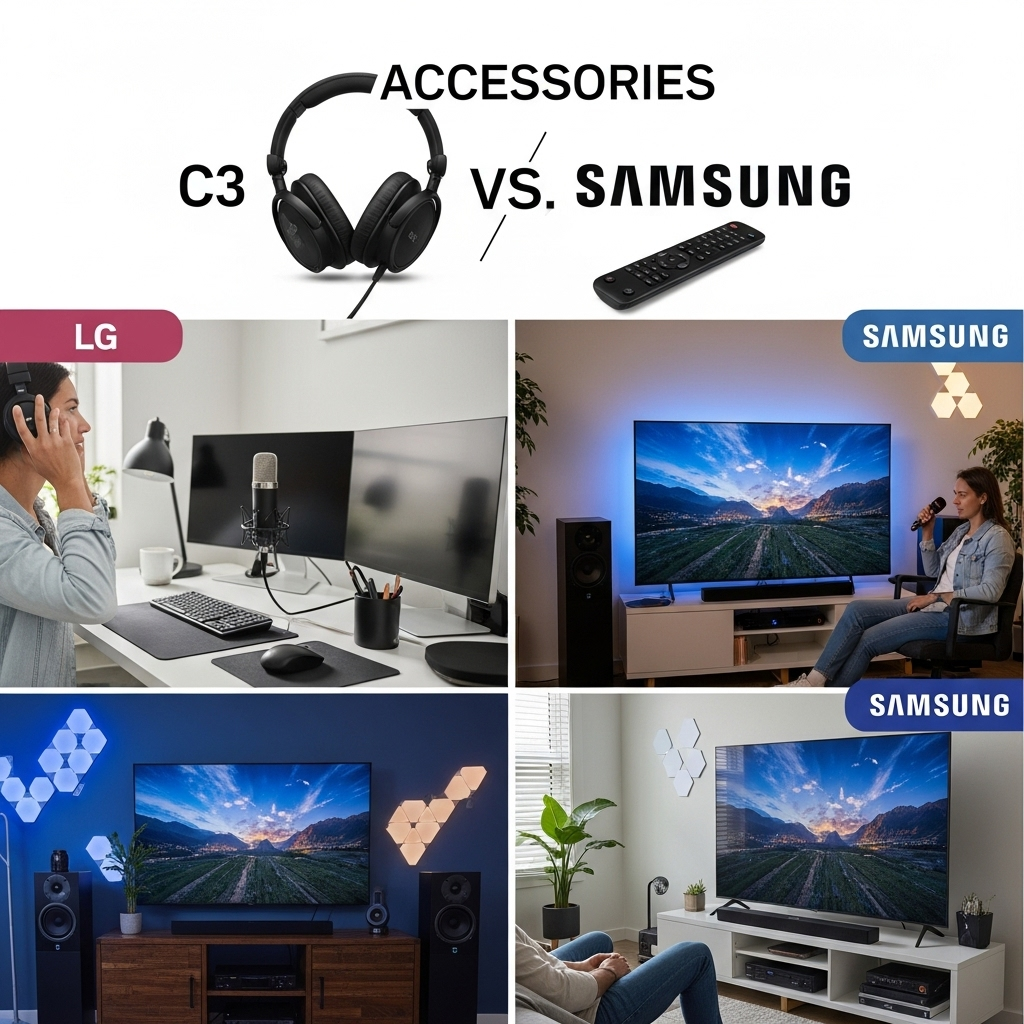LG C3 vs Samsung S90C: The C3 generally offers slightly better brightness and a more mature, refined processor, while the S90C boasts superior color vibrancy and a sleeker design. Both are fantastic OLED choices for most users, but the C3 may be better for bright rooms, and the S90C for cinematic immersion.
Choosing a new TV can feel like a big decision, especially when you’re looking at top-tier options like the LG C3 and Samsung S90C. Both are fantastic OLED TVs, meaning they offer incredible picture quality with perfect blacks and vibrant colors. But as you’re weighing your options, you might wonder which one is the best fit for your living room and your viewing habits. Don’t worry, we’ll break down the key differences in a way that’s easy to understand, helping you make the right choice with confidence. Let’s dive into what sets these two amazing TVs apart so you can pick the perfect one for your home entertainment setup!
The Big Picture: OLED vs. QD-OLED
Before we get into the nitty-gritty of LG C3 vs Samsung S90C, it’s helpful to understand the core technology. Both TVs use OLED (Organic Light-Emitting Diode) panels, which is a game-changer for picture quality. Unlike traditional LED TVs that rely on a backlight, each pixel in an OLED panel produces its own light. This means when a part of the screen needs to be black, those pixels simply turn off completely. This results in “perfect blacks” and an almost infinite contrast ratio, making colors pop and details in dark scenes incredibly clear.
The Samsung S90C, however, takes it a step further with QD-OLED technology. This combines the self-emissive nature of OLED with Quantum Dots, tiny nanoparticles that glow in specific colors when hit by light. This addition helps the S90C achieve even brighter colors and a wider color gamut compared to traditional OLEDs. The LG C3 uses LG’s advanced OLED Evo panel, which is already incredibly impressive and has seen improvements to brightness over previous years.
Think of it this way: both offer amazing picture quality, but the QD-OLED in the S90C is like adding a high-performance engine to an already superb car, pushing the boundaries of color and brightness even further.
LG C3: The Refined All-Rounder

The LG C3 OLED has long been a favorite for a reason. It consistently delivers a fantastic viewing experience for movies, TV shows, and gaming. LG has refined its OLED technology over the years, and the C3 benefits from this extensive experience.
Key Pros of the LG C3:
- Excellent Brightness: While not the absolute brightest TV on the market, the C3 offers a significant boost in brightness compared to its predecessors, making it a great performer even in moderately lit rooms.
- Superior Processing: LG’s Alpha 9 Gen 6 AI Processor is a powerhouse. It excels at upscaling lower-resolution content, reducing noise, and enhancing motion. This means your favorite shows and older movies will look sharper and smoother.
- Wide Viewing Angles: Like all OLEDs, the C3 has perfect viewing angles. The picture looks just as good from the side as it does from the front, which is great for larger living rooms.
- Mature Smart TV Platform (webOS): LG’s webOS is user-friendly, fast, and offers a vast selection of apps and streaming services. It’s intuitive even for those who aren’t super tech-savvy.
- Exceptional Gaming Features: The C3 is a gamer’s dream, offering four HDMI 2.1 ports (essential for next-gen consoles), support for 120Hz refresh rates, ALLM (Auto Low Latency Mode), and VRR (Variable Refresh Rate), including NVIDIA G-Sync and AMD FreeSync compatibility.
- Dolby Vision Support: The C3 supports Dolby Vision, a premium HDR format that can offer dynamic metadata to optimize picture quality scene by scene. This is a big plus for movie buffs who want the best possible HDR experience.
Considerations for the LG C3:
- Color Volume: While colors are excellent, the QD-OLED technology in the S90C can sometimes push vibrancy a little further.
- Design: The C3 is sleek, but the S90C might have a slight edge in sheer premium aesthetics and a thinner profile, depending on your preference.
Samsung S90C: The Vivid Contender
Samsung’s S90C QD-OLED TV represents a significant leap in their OLED offerings, aiming to deliver stunning visuals with its cutting-edge display technology. It’s designed to impress with its vibrant colors and striking contrast.
Key Pros of the Samsung S90C:
- Stunning Color Vibrancy: The QD-OLED panel truly shines here. Colors are incredibly rich, saturated, and lifelike. This makes HDR content, especially with vibrant scenes, absolutely breathtaking.
- Excellent Peak Brightness: The S90C is known for pushing brightness levels, which, combined with its perfect blacks, leads to incredible HDR impact. Details in both bright and dark areas are exceptionally well-defined.
- Sleek, Modern Design: Samsung often excels in design, and the S90C is no exception. It typically features a very slim profile and a premium look that can elevate any living space.
- Advanced Gaming Features: Similar to the C3, the S90C offers robust gaming support, though it has three HDMI 2.1 ports and one HDMI 2.0 port. It supports 120Hz, ALLM, VRR, and Samsung’s own Gaming Hub for cloud gaming without a console.
- Tizen Smart TV Platform: Samsung’s Tizen OS is very polished, fast, and offers a wide array of apps. It’s also known for its clean interface and excellent integration with other Samsung devices.
Considerations for the Samsung S90C:
- No Dolby Vision: Samsung famously does not support Dolby Vision. Instead, it uses HDR10+ for dynamic HDR, which is also excellent but less widely adopted than Dolby Vision by content creators.
- Processor Performance: While Samsung’s processors are very good, LG’s Alpha 9 processor in the C3 is often cited as being slightly more adept at handling motion and upscaling, particularly for content that isn’t native 4K.
- Potential for Burn-In (though much lower now): While QD-OLED technology has significantly improved, extended, static image viewing at high brightness levels is still something to be mindful of, as with all OLEDs. Manufacturers have robust mitigation systems in place.
Side-by-Side Comparison: Features at a Glance

Let’s break down how these two titans stack up in a simple table. This should help you see the key differences quickly.
| Feature | LG C3 OLED | Samsung S90C QD-OLED |
|---|---|---|
| Panel Type | OLED Evo | QD-OLED |
| Processor | Alpha 9 Gen 6 AI Processor | Neural Quantum Processor 4K |
| Max Brightness (Typical) | Very Good (Improved over C2) | Excellent (Higher peak highlights) |
| Color Performance | Excellent | Exceptional (Wider color gamut due to QD) |
| HDR Format Support | Dolby Vision, HDR10, HLG | HDR10+, HDR10, HLG |
| HDMI 2.1 Ports | 4 | 3 |
| Gaming Features | 120Hz, VRR, ALLM, G-Sync/FreeSync | 120Hz, VRR, ALLM, Samsung Gaming Hub |
| Smart TV OS | webOS | Tizen |
| Design | Sleek, premium | Ultra-slim, premium aesthetic |
| Best Use Case | Bright rooms, versatile viewing, gaming, Dolby Vision content | Dark rooms, cinematic immersion, vibrant HDR content, gaming |
Who Should Buy the LG C3?
You’ll likely be thrilled with the LG C3 if you:
- Watch TV in a room with ambient light: The C3’s improved brightness handles reflections and daylight better than many OLEDs, making it a more versatile choice for daytime viewing.
- Love Dolby Vision content: If you’re a big fan of Netflix, Disney+, or other services that heavily utilize Dolby Vision for their flagship shows and movies, the C3’s support is a significant advantage.
- Want the most refined processing: For those who are particular about how motion is handled or want the best possible upscaling for lower-quality streams or older Blu-rays, LG’s Alpha 9 processor is hard to beat.
- Are a serious gamer with multiple next-gen consoles: Having four full HDMI 2.1 ports means you can connect up to four devices (like PS5, Xbox Series X, gaming PC, and a soundbar) and benefit from all the latest gaming technologies without needing to swap cables. You can learn more about HDMI 2.1 capabilities at HDMI.org.
- Prefer a mature and stable smart TV experience: webOS has been around for a while and is very well-loved for its ease of use and extensive app support.
Who Should Buy the Samsung S90C?

The Samsung S90C might be your perfect match if you:
- Prioritize ultimate color vibrancy and HDR impact: For a truly cinematic look with stunningly punchy colors that leap off the screen, the QD-OLED technology is a revelation.
- Primarily watch in a dimmer, controlled environment: In a dark or dimly lit room, the S90C’s incredible contrast and brightness capabilities are showcased to their fullest, offering an immersive home theater experience.
- Value cutting-edge design: The ultra-slim profile and premium finishes of the S90C make it a statement piece that can blend seamlessly into a modern home.
- Are interested in Samsung’s ecosystem or Gaming Hub: If you own other Samsung devices, the integration can be seamless. The Gaming Hub also offers a convenient gateway to cloud gaming services.
- Don’t mind the lack of Dolby Vision: While a feature many competitors offer, Samsung’s commitment to HDR10+ means you’re still getting a fantastic HDR experience, just in a different format.
Understanding Brightness and Color on OLEDs
It’s worth touching on brightness and color because these are often the most talked-about differences between OLED TVs. For a long time, OLEDs were known for being dimmer than their LED counterparts, especially in bright rooms. Both the LG C3 and Samsung S90C have made huge strides here.
The LG C3 uses an “OLED Evo” panel, which LG states pushes brightness further than previous generations. It’s very capable and will handle most viewing scenarios well.
The Samsung S90C, with its QD-OLED panel, tends to hit higher peak brightness levels, especially in small highlights (think specular highlights in HDR). This can make HDR content appear even more impactful. Crucially, the Quantum Dots in the S90C also contribute to a wider color gamut, meaning it can display more shades of color, especially at higher brightness levels. This results in colors that are not just bright, but also more saturated and pure looking.
For everyday viewing, both are excellent. But if you’re comparing them side-by-side, especially with demanding HDR content in mind, the S90C often has a slight edge in both brightness and color exuberance. When it comes to staying vibrant without compromising color accuracy at higher brightness, QD-OLED has a unique advantage.
Gaming on the C3 vs. S90C

Gamers, rejoice! Both the LG C3 and Samsung S90C are phenomenal choices for gaming. They both offer near-instantaneous response times (which is a hallmark of OLEDs), incredibly low input lag, and support for key next-generation gaming features.
- HDMI 2.1 Ports: This is crucial. HDMI 2.1 allows for 4K resolution at 120 frames per second (120Hz), Variable Refresh Rate (VRR), and Auto Low Latency Mode (ALLM). The C3 has an advantage here with four full HDMI 2.1 ports, while the S90C has three HDMI 2.1 ports and one HDMI 2.0 port. If you have multiple current-gen consoles and a gaming PC that all need to run at their best, the C3 offers more flexibility.
- VRR Support: Both TVs support VRR, which syncs the TV’s refresh rate with your game’s frame rate. This eliminates screen tearing and stuttering, leading to a much smoother gameplay experience. Both support AMD FreeSync and NVIDIA G-Sync Compatible technologies.
- ALLM: When you launch a game, ALLM automatically switches the TV to its low-latency “Game Mode,” ensuring responsive controls. Both TVs do this excellently.
- Samsung Gaming Hub: The S90C includes the Samsung Gaming Hub, which is a built-in platform for cloud gaming services like Xbox Game Pass, GeForce Now, and Amazon Luna without needing a console. This is a unique feature that can be very appealing.
For the absolute hardcore gamer with multiple high-demand devices, the C3’s extra HDMI 2.1 port might be the deciding factor. However, for most gamers, the gaming experience on either TV will be absolutely top-notch, with the S90C’s extra vibrant picture adding an extra layer of immersion.
Smart TV Platforms: webOS vs. Tizen
The smart TV interface is how you’ll access apps, settings, and streaming services. Both LG’s webOS and Samsung’s Tizen are considered among the best in the business.
- LG’s webOS: It’s clean, intuitive, and highly customizable. LG has focused on a user-friendly experience with quick access to your favorite apps and inputs. It offers a vast library of streaming services and a well-integrated voice assistant. Many find it to be one of the easiest smart TV systems to navigate.
- Samsung’s Tizen: Tizen is also very slick, fast, and visually appealing. It’s known for its organization and often integrates very well with other Samsung devices. The Samsung Gaming Hub is a standout feature for gamers and cloud streamers.
Ultimately, the choice between webOS and Tizen often comes down to personal preference. Both are excellent, speedy, and offer all the major streaming apps you could want. If you have a lot of other Samsung smart home devices, Tizen might feel more integrated, but webOS is incredibly robust and easy to pick up for anyone.
Frequently Asked Questions (FAQ)
Here are some common questions people have when comparing these two excellent TVs:
Which TV is brighter, the LG C3 or Samsung S90C?
The Samsung S90C generally achieves higher peak brightness, especially in small highlights within HDR content, due to its QD-OLED technology. The LG C3 is also very bright, with significant improvements over previous models, making it excellent, but the S90C usually has an edge in sheer luminance.
Which TV has better colors, LG C3 or Samsung S90C?
The Samsung S90C, utilizing QD-OLED technology, typically displays a wider color gamut and more saturated, vibrant colors than the LG C3. This means colors can appear richer and more impactful, especially in HDR. Both offer excellent color accuracy, but the S90C often leads in vibrancy.
Does the LG C3 or Samsung S90C have better gaming features?
Both are fantastic for gaming. The LG C3 has an advantage with four full HDMI 2.1 ports, ideal for multiple next-gen consoles. The Samsung S90C has three HDMI 2.1 ports and includes the Samsung Gaming Hub for cloud gaming. Both support 120Hz, VRR, and ALLM.
Which TV has better upscaling and motion handling?
The LG C3, with its Alpha 9 Gen 6 AI Processor, is often praised for its superior motion handling and upscaling capabilities, especially for lower-resolution content. While the S90C’s processor is very good, LG’s processing is generally considered slightly more refined for these tasks.
Does the S90C support Dolby Vision?
No, the Samsung S90C does not support Dolby Vision. It supports HDR10+, HDR1
